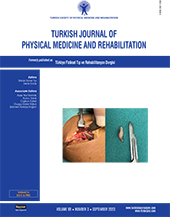The effect of Jendrassik maneuver on the persistence of the peroneal nerve F-wave
2 Department of Neurology, University of Health Sciences, Adana City Training and Research Hospital, Adana, Türkiye DOI : 10.5606/tftrd.2023.10931 Objectives: This study investigated whether peroneal nerve F-wave persistence increased when the Jendrassik maneuver (JM) was performed, aiming to obtain information about the physiology of F-waves and JM.
Patients and methods: Thirty healthy individuals (HIs; 17 females, 13 males; mean age: 33.6±8.2 years; range, 23-50 years) were included in the prospective experimental study conducted between June 15, 2021, and December 15, 2021. Nerve conduction studies of peroneal, superficial peroneal, posterior tibial, and sural nerves were performed in one extremity of each HI. The peroneal nerve F-wave study was performed at rest (Study 1), during JM (Study 2), and after JM (Study 3). F-wave persistence of the peroneal nerve, maximum F-wave amplitude (ampF-wavemax), mean F-wave amplitude (ampF-wavemean), minimum F-wave latency, and the ratio of ampF-wavemean to maximum M amplitude (F/M ratio) were analyzed.
Results: The mean peroneal nerve F-wave persistence in Study 1, Study 2, and Study 3 was 28.7±23.9%, 52.3±32.1%, and 34.7±29.0%, respectively. F-wave persistence in Study 2 was higher compared to Studies 1 and 3 (p<0.001 and p<0.001, respectively). Moreover, ampF-wavemax, ampF-wavemean, and F/M ratio in Study 2 were higher than Studies 1 and 3 (p=0.026 and p=0.021 for ampF-wavemean; p=0.015 and p=0.003 for ampF-wavemax; p=0.033 and p=0.015 for F/M ratio, respectively). F-wave persistence in Study 2 was positively correlated with ampF-wavemax and ampF-wavemean (p<0.001, r= 0.717; p<0.001, r=0.786, respectively).
Conclusion: This study demonstrated that JM increased F-wave persistence and amplitude. Jendrassik maneuver may show its effect through motor neuron excitability.
Keywords : F-wave persistence, F-wave, motor neuron excitability, Jendrassik maneuver, peroneal nerve

















